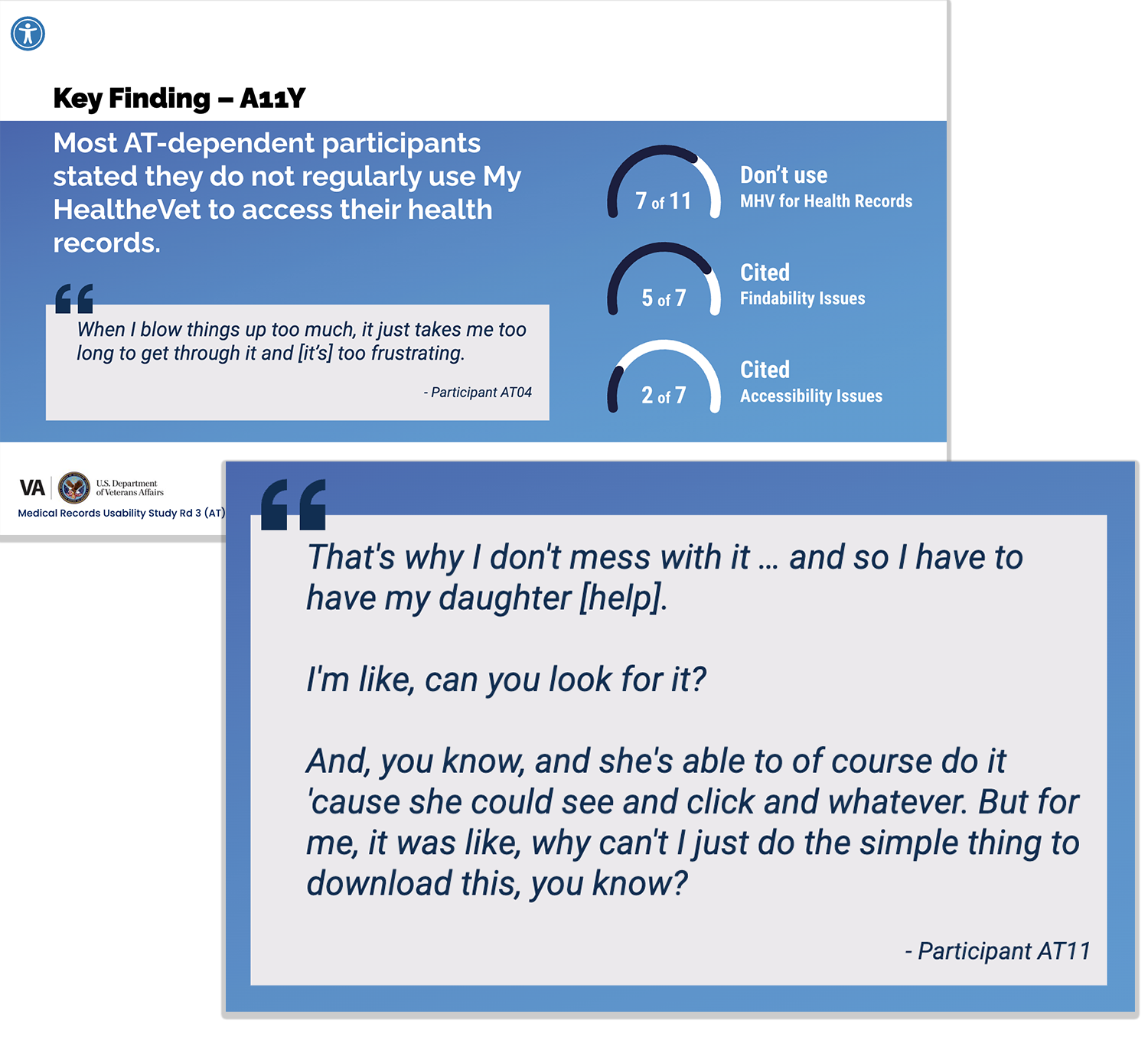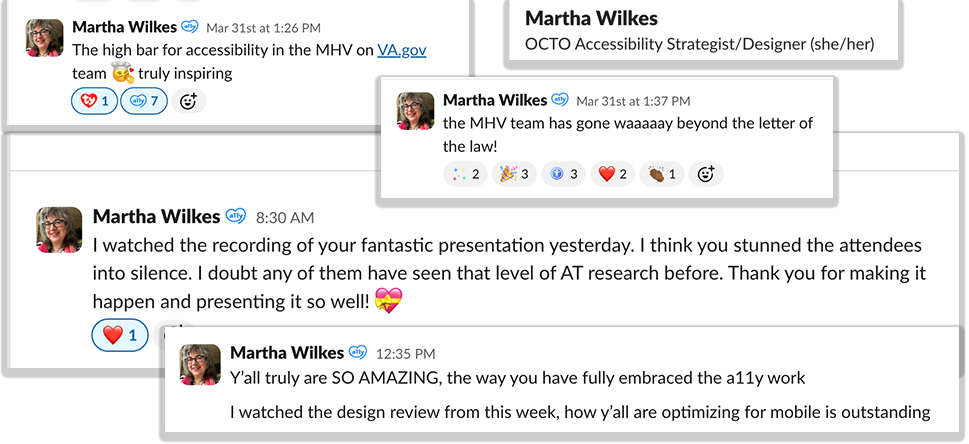
Building an Accessibility Research Practice: Advancing Inclusive UX
Client: Veteran Affairs
Timeline: November 2022 - July 2025
Role: UX Research Lead
Accessibility Research by the Numbers:
Assistive Technology (AT) Studies:
Screen Reader Users:
Magnification Users:
Voice Command Users:
Users with Cognitive Disabilities:
Legacy My HealtheVet tools weren’t accessible, leaving some Veterans unable to independently manage their health. The migration to VA.gov created an opportunity to use research as a catalyst for inclusive design.
Accessibility wasn’t just a checklist, it was a chance to ensure Veterans with disabilities could engage fully with their healthcare.
Background: Centering Accessibility in Digital Health
Recruiting the Right Participants
Finding Veterans who relied on assistive technology (AT) was one of the biggest challenges. Standard recruitment rarely reached users of screen readers, magnifiers, or voice command tools, and even when they did, participants often didn’t meet study criteria.
To fix this, I developed and refined a custom AT screener that accurately identified Veterans who used assistive technology in their daily lives. Over multiple research cycles, this tool proved highly effective, making our team one of the most successful across the VA at recruiting AT participants.
The final version was shared with other VA research teams, helping establish consistent, inclusive recruiting practices for accessibility studies.
A refined screener turned accessibility testing from a one-off effort into a scalable, repeatable research practice across VA teams.
Even with a strong screener, recruiting qualified assistive technology (AT) users was challenging. Many contracted recruiters didn’t understand the nuances of AT or how Veterans relied on it.
To make inclusive testing possible, I:
Added an AT reference chart to every research plan to help recruiters match participants correctly.
Built and maintained an internal database of qualified AT users who opted into future studies.
Partnered directly with VA leadership and accessibility experts to secure participation exceptions and recruit from the Blinded Veterans Association when needed.
These efforts transformed recruitment from a barrier into a repeatable process: one that other VA teams soon adopted.
Breaking Barriers: How Persistence and Partnership Made Inclusive Testing Possible
Persistence and collaboration turned recruiting challenges into a scalable model for inclusive research.
To understand the challenges Veterans face, I personally completed usability tasks using screen readers, magnifiers, and voice command tools across all supported devices.
Struggling through these tasks, and watching AT-dependent Veterans take more than twice as long as non-disabled users on most tasks, deepened my empathy and strengthened my advocacy for accessibility testing, even when stakeholder priorities were focused elsewhere.
After each testing round, I reviewed recordings in detail to analyze behavior and uncover issues missed during live sessions. When problems surfaced, I recreated the exact testing environment with the same device, browser, and assistive tech setup to pinpoint and resolve root causes with our accessibility specialist.
This hands-on rigor led to targeted design and code changes that improved usability for Veterans and prevented launch-blocking accessibility issues.
Walking a Mile in Their Tools
Hands-on research turned invisible barriers into measurable improvements for Veterans’ digital healthcare experience.
Cognitive Accessibility: Listening to Veterans’ Experiences
To better support Veterans with cognitive disabilities, I created a specialized screener to identify participants with self-reported cognitive challenges. Like the AT screener, it evolved through multiple research cycles and was later shared across the VA research community.
To deepen understanding, I added a short post-session interview exploring how cognitive challenges affected Veterans’ ability to manage their healthcare online.
Responses were de-identified, analyzed for patterns, and synthesized into insights that informed design improvements and educated stakeholders.
This structured approach turned feedback into a consistent, research-backed understanding of how to design for cognitive accessibility.
Building structure around how we engage Veterans with cognitive disabilities turned anecdotal feedback into research-backed insights that guided inclusive design decisions.
To help stakeholders grasp the impact of accessibility barriers, I created short video clips from usability sessions with Veterans using assistive technology.
The footage revealed the time, effort, and frustration behind everyday tasks, helping teams move beyond compliance to truly understand the user experience.
In research readouts, I paired these moments with data from Veterans with cognitive disabilities, showing how design choices can support, or hinder, their ability to manage healthcare.
This framing built empathy and reinforced the need to design for both cognitive and physical accessibility.
When the VA design lead requested more resources, I developed a shareable guide summarizing Veterans’ challenges and inclusive design principles to guide future work.
Educating Stakeholders Through Evidence and Empathy
By pairing usability footage with research-driven insights, I helped stakeholders see the lived challenges of Veterans using assistive technology, turning accessibility from a checklist into a shared responsibility.
The accessibility research my team and I led earned recognition across the VA UX community for setting a new standard in assistive technology research.
VA’s Accessibility Lead, Martha Wilkes, often praised our work for going “beyond the letter of the law,” and invited us to present our findings to the Blinded Veterans Association on multiple occasions.
Most meaningfully, the Veterans themselves expressed gratitude, sending a Certificate of Recognition for my contribution to improving accessibility in VA’s digital health tools.
Recognition That Matters Most: From the Veterans Themselves
Recognition from accessibility leaders and Veterans alike affirmed that my work went beyond compliance, it made healthcare meaningfully more accessible for those who served.
Independence Through Accessibility
This work went beyond improving individual products. It helped establish a sustainable accessibility research practice within the VA’s Digital Health Modernization effort. By embedding cognitive disability testing into every study and advocating for frequent AT testing, I demonstrated how accessibility could be fully integrated into the research process rather than treated as an afterthought.
“You give us independence, and that is huge.”
That single statement captures the lasting impact of this work: research that not only improved usability, but laid the foundation for ongoing accessibility advocacy and practice across teams.
Accessibility is how we turn usability into empowerment and practice into progress.












